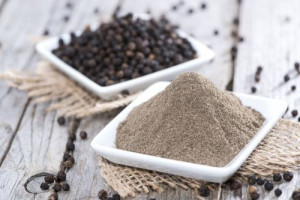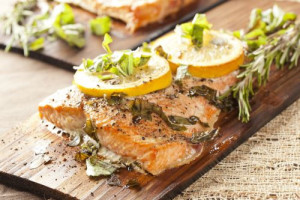Pepper
NEWS: This superfood is now available in the SANEStore as a convenient whole-food powder so you can more easily enjoy it in smoothies and recipes.
Pepper is commonly described as the “king of spices,” and it shares a place on most dinner tables with salt. The word pepper originated from the Sanskrit word pippali, meaning berry. Black pepper is a flowering vine in the family Piperaceae, cultivated for its fruit, which is usually dried and used as a spice and seasoning. The fruit, known as a peppercorn when dried, is dark red when fully mature, and, like all drupes, contains a single seed.

Piperine is a pungent compound found in the fruit of the plants in the Piperaceae family, the most famous member of which is Piper nigrum, black pepper. It has a long history of use in Ayurvedic medicine as a restorative food. Piperine may be able to increase bioavailability of many substances through a number of mechanisms. The results of these actions are that substances reach, enter and remain within their target cells for longer periods of time than would normally be the case. Therefore, piperine can turn a marginally effective therapeutic substance into a highly effective one by increasing its bioavailability and intracellular residency time.
Piperine works by supporting the digestive enzymes of the pancreas, thereby supporting digestive capacity and may significantly reduces gastrointestinal food transit time. Black pepper or piperine treatment has also been evidenced to support healthy lipid levels in vivo and beneficially influence the cellular status of organic sulfur compounds, antioxidant molecules, and antioxidant enzymes in a number of experimental situations of oxidative stress.
In a study reported in the September edition of the journal Food and Chemical Toxicology the effect of various doses of piperine was determined. Results showed that piperine at all dosage ranges used in the study possessed possible antidepressant like activity and cognitive enhancing effects at all treatment durations. Researchers determined that piperine is a functional food that may improve brain function.
The medicinal properties of various compounds such as curcumin cannot be well utilized because of poor bioavailability due to its rapid metabolism in the liver and intestinal wall. In an older study reported in Planta Medica, the effect of combining piperine, was evaluated to determine the bioavailability of curcumin in rats and healthy human volunteers. When curcumin was given alone to the rats, moderate serum concentrations were achieved over a period of 4 hours. When piperine was added with the curcumin, the serum concentration of curcumin increased for a 1-2 hour period. Time to maximum concentration was significantly increased while elimination half life and clearance significantly decreased. The bioavailability was increased by 154%. When curcumin was given alone to humans, serum levels were either undetectable or very low. Addition of piperine produced much higher concentrations from 0.25 to 1 hour following administration. The bioavailability of curcumin when taken with piperine increased 2000%.
When you use Z Natural Foods organic black pepper, you will be yielding between 5-10% piperine per serving. This is a simple and great add on to any dish to make the average meal into a superfood meal.
[/av_textblock]
Sound Promising?
Want to Try Adding a Convenient and Pure Powdered Form of This Whole Food to Your Smoothies and Recipes?
Why Try Pepper Superfood?
- May support brain health
- May support a healthy mental outlook
- May increase bioavailability of other nutrients and compounds
- May support a healthy colon and bowel
- May support a healthy inflammation response
- May support the immune systems ability to prevent the formation of mutated cells
References
1. Abila B, Richens A, Davies JA. Anticonvulsant effects of extracts of the west African black pepper, Piper guineense. J Ethnopharmacol 1993 Jun;39(2):113-7. 1993. PMID:16400.
2. http://www.ncbi.nlm.nih.gov/pubmed/25554982
3. http://www.whfoods.com/genpage.php?tname=foodspice&dbid=74#nutritionalprofile
4. http://www.ncbi.nlm.nih.gov/pubmed/25541091
5. Wood, Rebecca. The Whole Foods Encyclopedia. New York, NY: Prentice-Hall Press; 1988. 1988. PMID:15220.
6. http://www.ncbi.nlm.nih.gov/pubmed/25479727
7. Murray MT. The Healing Power of Foods. Prima Publishing, Rocklin, CA, 1993, pp. 211-212. 1993.
8. http://www.ncbi.nlm.nih.gov/pubmed/25446579
9. Mujumdar AM, Dhuley JN, Deshmukh VK, et al. Anti-inflammatory activity of piperine. Jpn J Med Sci Biol 1990 Jun;43(3):95-100. 1990. PMID:16380.
10. http://www.ncbi.nlm.nih.gov/pubmed/25444919
11. Fortin, Francois, Editorial Director. The Visual Foods Encyclopedia. Macmillan, New York. 1996.
12. http://www.ncbi.nlm.nih.gov/pubmed/25438036
13. Grieve M. A Modern Herbal. Dover Publications, New York. 1971.
14. http://www.ncbi.nlm.nih.gov/pubmed/25384161
15. Grieve M. A Modern Herbal. Dover Publications, New York. 1971.
16. http://www.ncbi.nlm.nih.gov/pubmed/25375334
17. Ensminger AH, Esminger M. K. J. e. al. Food for Health: A Nutrition Encyclopedia. Clovis, California: Pegus Press; 1986. 1986. PMID:15210.
18. http://www.ncbi.nlm.nih.gov/pubmed/25331343
19. Ensminger AH, Ensminger, ME, Kondale JE, Robson JRK. Foods & Nutriton Encyclopedia. Pegus Press, Clovis, California. 1983.
20. http://www.ncbi.nlm.nih.gov/pubmed/25327968
21. Dorman HJ, Deans SG. Antimicrobial agents from plants: antibacterial activity of plant volatile oils. J Appl Microbiol 2000 Feb;88(2):308-16. 2000. PMID:16390.
22. http://www.ncbi.nlm.nih.gov/pubmed/25173461
23. Calucci L, Pinzino C, Zandomeneghi M et al. Effects of gamma-irradiation on the free radical and antioxidant contents in nine aromatic herbs and spices. J Agric Food Chem 2003 Feb 12; 51(4):927-34. 2003.
24. http://www.ncbi.nlm.nih.gov/pubmed/25166889
25. Ao P, Hu S, Zhao A. [Essential oil analysis and trace element study of the roots of Piper nigrum L.]. Zhongguo Zhong Yao Za Zhi 1998 Jan;23(1):42-3, 63. 1998. PMID:16370.
26. http://www.ncbi.nlm.nih.gov/pubmed/25153972
27. Merck Index, 11th Edition, 7442
28. http://www.ncbi.nlm.nih.gov/pubmed/25141367
29. Epstein, William W.; Netz, David F.; Seidel, Jimmy L. (1993). “Isolation of piperine from black pepper”. J. Chem. Ed. 70 (7): 598. doi:10.1021/ed070p598.
30. http://www.ncbi.nlm.nih.gov/pubmed/25119528
31. Oersted, “Über das Piperin, ein neues Pflanzenalkaloid” [On piperine, a new plant alkaloid], (Schweigger’s) Journal für Chemie und Physik, vol. 29, no. 1, pages 80-82 (1820).
32. http://www.ncbi.nlm.nih.gov/pubmed/25050023
33. McNamara FN, Randall A, Gunthorpe MJ (March 2005). “Effects of piperine, the pungent component of black pepper, at the human vanilloid receptor (TRPV1)”. Br. J. Pharmacol. 144 (6): 781–90. doi:10.1038/sj.bjp.0706040. PMC 1576058. PMID 15685214.
34. http://www.ncbi.nlm.nih.gov/pubmed/25027570
35. Atal CK, Dubey RK, Singh J (January 1985). “Biochemical basis of enhanced drug bioavailability by piperine: evidence that piperine is a potent inhibitor of drug metabolism”. J. Pharmacol. Exp. Ther. 232 (1): 258–62. PMID 3917507.
36. http://www.ncbi.nlm.nih.gov/pubmed/24835937
37. Bhardwaj RK, Glaeser H, Becquemont L, Klotz U, Gupta SK, Fromm MF (August 2002). “Piperine, a major constituent of black pepper, inhibits human P-glycoprotein and CYP3A4”. J. Pharmacol. Exp. Ther. 302 (2): 645–50. doi:10.1124/jpet.102.034728. PMID 12130727.
38. http://www.ncbi.nlm.nih.gov/pubmed/24819444
39. Srinivasan, K (2007). “Black pepper and its pungent principle-piperine: A review of diverse physiological effects”. Critical Reviews in Food Science and Nutrition 47 (8): 735–48. doi:10.1080/10408390601062054. PMID 17987447.
40. http://www.ncbi.nlm.nih.gov/pubmed/24816193
41. Shoba G, Joy D, Joseph T, Majeed M, Rajendran R, Srinivas PS (May 1998). “Influence of piperine on the pharmacokinetics of curcumin in animals and human volunteers”. Planta Med. 64 (4): 353–6. doi:10.1055/s-2006-957450. PMID 9619120.
42. http://www.ncbi.nlm.nih.gov/pubmed/24525095
43. Wattanathorna, Jintanaporn; Pennapa Chonpathompikunlertb; Supaporn Muchimapuraa; Aroonsri Pripremc; Orathai Tankamnerdthai (September 2008). “Piperine, the potential functional food for mood and cognitive disorders”. Food and Chemical Toxicology 46 (9): 3106–3110. doi:10.1016/j.fct.2008.06.014. PMID 18639606.
44. http://www.ncbi.nlm.nih.gov/pubmed/24418140
45. Singh J, Dubey RK, Ata CK l (1986). “Piperine-mediated inhibition of glucuronidation activity in isolated epithelial cells of the guinea-pig small intestine: evidence that piperine lowers the endogeneous UDP-glucuronic acid content”. Pharamcol. Exp. Ther. 236: 488–493.
46. http://www.ncbi.nlm.nih.gov/pubmed/24388894
47. Reen RK, Jamwal DS, Taneja SC, et al. (July 1993). “Impairment of UDP-glucose dehydrogenase and glucuronidation activities in liver and small intestine of rat and guinea pig in vitro by piperine”. Biochem. Pharmacol. 46 (2): 229–38. doi:10.1016/0006-2952(93)90408-O. PMID 8347144.
48. http://www.ncbi.nlm.nih.gov/pubmed/24387754
49. Johnson, J. J.; Nihal, M; Siddiqui, I. A.; Scarlett, C. O.; Bailey, H. H.; Mukhtar, H; Ahmad, N (2011). “Enhancing the bioavailability of resveratrol by combining it with piperine”. Molecular Nutrition & Food Research 55 (8): 1169–76. doi:10.1002/mnfr.201100117. PMC 3295233. PMID 21714124.
50. http://www.ncbi.nlm.nih.gov/pubmed/24370971
51. Faas, L.; Venkatasamy, R.; Hider, R. C.; Young, A. R.; Soumyanath, A. (2008). “In vivo evaluation of piperine and synthetic analogues as potential treatments for vitiligo using a sparsely pigmented mouse model”. British Journal of Dermatology 158 (5): 941–50. doi:10.1111/j.1365-2133.2008.08464.x. PMID 18284389.
52. http://www.ncbi.nlm.nih.gov/pubmed/24348547
53. Ikan, Raphael (1991). Natural Products: A Laboratory Guide 2nd Ed.. San Diego: Academic Press, Inc. pp. 223–224. ISBN 0123705517.
54. http://www.ncbi.nlm.nih.gov/pubmed/24329956
55. Gaikar. Process for extraction of piperine from piper species. US 6365601, April 2, 2002.
56. http://www.ncbi.nlm.nih.gov/pubmed/24260564
57. http://www.tis-gdv.de/tis_e/ware/gewuerze/pfeffer/pfeffer.htm#selbsterhitzung
58. http://www.ncbi.nlm.nih.gov/pubmed/24250643
59. Pharmacographia (London: Macmillan & Co., 1879), p. 584.
60. http://www.ncbi.nlm.nih.gov/pubmed/24193053
61. Annalen, 1850, 75, 82; 84, 345, cf. Wertheim and Rochleder, ibid., 1845, 54, 255.
62. http://www.ncbi.nlm.nih.gov/pubmed/24188307
63. Stenhouse in Pharm. J., 1855, 14, 363.
64. http://www.ncbi.nlm.nih.gov/pubmed/24050594
66. http://www.ncbi.nlm.nih.gov/pubmed/24005374
67. Majeed, M. Use of piperine as a bioavailability enhancer. US Patent 5744161, October 26, 1999.
68. http://www.ncbi.nlm.nih.gov/pubmed/23993499
69. Babo & Keller, Journ. pr. chem., 1857, 72, 53.
70. http://www.ncbi.nlm.nih.gov/pubmed/23905652
71. Rugheimer, Ber., 1882, 15, 1390.
72. http://www.ncbi.nlm.nih.gov/pubmed/23895150
73. Manoharan S, Balakrishnan S, Menon V, et al. Singapore Med J. 2009 Feb;50(2):139-46.
74. http://www.ncbi.nlm.nih.gov/pubmed/23886380
75. “Pepper ‘to treat pigment disease'”. BBC News. 2008-02-14.
76. http://www.ncbi.nlm.nih.gov/pubmed/23870999
77. Bang JS, Oh DH, Choi HM, et al. Arthritis Res Ther. 2009 Mar 30;11(2):R49.
78. http://www.ncbi.nlm.nih.gov/pubmed/23868040
79. Doucette CD, Hilchie AL, Liwski R, Hoskin DW. J Nutr Biochem 2013;24:231-239.
80. http://www.ncbi.nlm.nih.gov/pubmed/23838114
81. http://www.ncbi.nlm.nih.gov/pubmed/23824300
82. http://www.ncbi.nlm.nih.gov/pubmed/23791964
83. http://www.ncbi.nlm.nih.gov/pubmed/23768180
84. http://www.ncbi.nlm.nih.gov/pubmed/23750076
85. http://www.ncbi.nlm.nih.gov/pubmed/23625885
86. http://www.ncbi.nlm.nih.gov/pubmed/23153036 87. http://nutritionfacts.org/2015/02/05/why-pepper-boosts-turmeric-blood-levels








